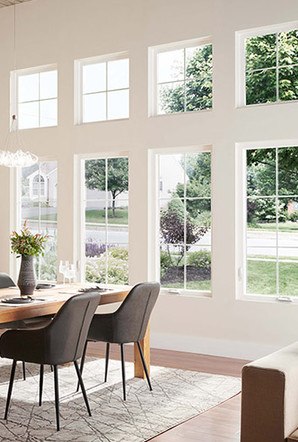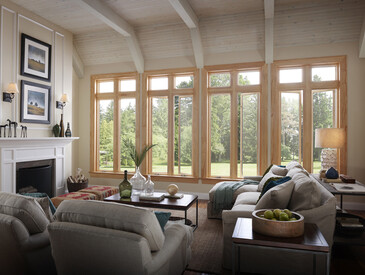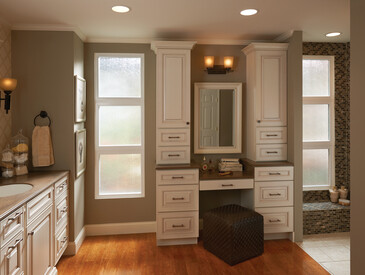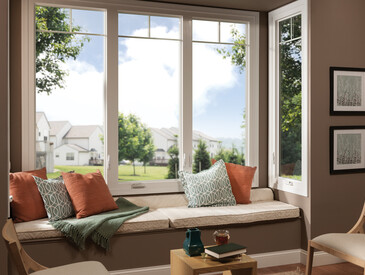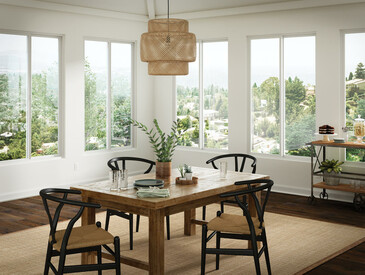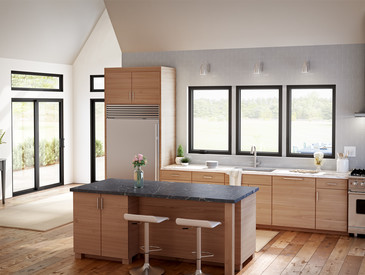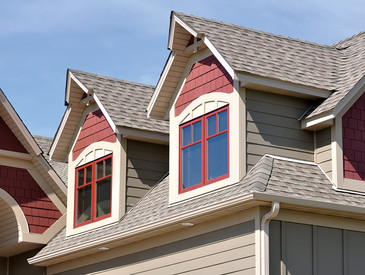There’s nothing quite like floor to ceiling windows. Whether you have them throughout your house or in a particular room, these “window walls” provide great views and lots of natural light. If you’re in the market for ceiling to floor windows, we can help you determine what style works best in your home. Do you want especially large glass windows, or mulled window units? Do you want curtains for your floor to ceiling windows? Are you really in the market for floor to ceiling glass doors instead of windows? Let’s cover floor to ceiling windows from top to bottom.
What Are Floor to Ceiling Windows?
Essentially, there are two kinds of floor to ceiling windows. You can install full-length windows that feature one very large panel of glass, or you can use mulled units, which are two or more units installed next to one another. If you choose the latter, chances are you’ll use combination windows, such as a horizontal slider on top of an awning window. This pattern will then be continued across the wall and – if desired – around the entire room.
There are also floor to ceiling glass doors, which are a great option if your space overlooks a deck or patio. Thanks to advances in technology, many companies today are even manufacturing “moving glass walls.” Floor to ceiling glass doors are awe-inspiring, easy to operate, and surprisingly energy efficient.
Advantages of Floor to Ceiling Windows
As noted above, the “wow” factor of floor to ceiling windows cannot be overstated. They truly make people sit up and take notice, especially if the room looks out onto some spectacular views. The benefit of natural light is compounded in a room with full-length windows, making it an ideal space to unwind, read, watch TV, or even take a nap. These windows can also make a room feel larger, extending the indoors into the outdoors. Finally, having full-length windows can improve your home’s curb appeal and increase its value when you’re ready to sell.
Disadvantages of Floor to Ceiling Windows
If privacy is your top concern, then full wall windows may not be for you. After all, there is plenty of glass space for people to see in. You can alleviate this issue with blinds or curtains for floor to ceiling windows, though many people prefer to keep the windows visible so they can appreciate the views.
Another potential issue is energy performance. It’s just a fact that a window will never block outside air as well as a wall or door. But this too can be alleviated with the help of modern technology. As we’ll address later, the energy-efficient windows on the market today would have been unheard of a generation ago.
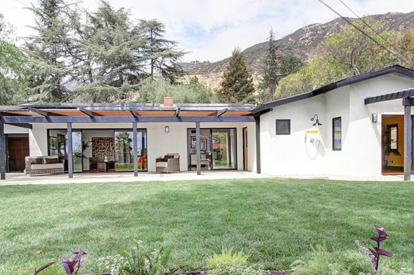
Considerations for Installing Floor to Ceiling Windows
Placing floor to ceiling windows in your home is a big decision that will greatly change the appearance of your home on both the outside and inside. If you’re thinking about this step, you should ask yourself what you’re hoping to gain. More sunlight? Greater views to the outside? An aesthetic look that will impress your neighbors and increase your home’s resale value? Those are all good reasons for installing large glass windows, but they aren’t your only considerations.
Energy Efficiency
The floor to ceiling windows on the market today – in addition to patio doors and other window styles – are much more energy efficient than those of the past. Nearly every window manufactured today has a warm-edge spacer system, which greatly improves a window’s energy performance. What’s more, there are numerous upgrades (Low-E glass coatings, gas between the panes, etc.) that will add to the window’s energy efficiency.
Cost
Window walls can be a bit pricey. You are paying for a complicated installation involving large expanses of glass. With that being said, there are ways to reduce the cost, such as forgoing aesthetic options like grids or rain glass. Plus, companies will work with you on pricing.
Safety
Not unlike the innovations in energy performance, window-and-door manufacturers have also upgraded their locking systems in recent years. You can also ask your window salesperson about optional upgrades on your locking system.
Lighting
This is one of the big selling points of floor to ceiling windows – natural lighting. With window walls and moving glass walls, you’ll get plenty of sunlight in your space, making these rooms ideal for unwinding after a long day at work. Indeed, floor to ceiling windows are especially popular in sunrooms for this very reason.
Cleaning
Maintaining a pristine appearance on your window walls is remarkably easy. For one thing, many windows used as floor to ceiling windows are picture windows, so there’s no meeting rail to work around as you’re cleaning. Naturally, the one challenge of floor to ceiling windows is that you must reach high to get to the top; however, a common household stepladder should do the job in most situations.
Finding the Perfect Floor to Ceiling Windows for Your Home
When deciding what floor to ceiling windows work for your space, you’ll have plenty to consider. Do you want a series of large picture windows, one extremely large window – a full wall window, if you will – or a configuration of different windows? You could also install a moving glass wall system to get the look you’re hoping for.
These and other window ideas could truly revolutionize the look of your home. To get started, find a Milgard dealer near you. Before you know it, that full-length window you’ve been dreaming of will be a reality.













